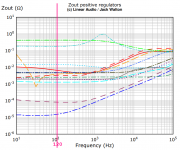Simple Ripple Eater PSU, output impedance
http://hifisonix.com/simple-ripple-eater-psu-for-the-sx-and-kx-amplifiers/
One question about the Simple Ripple Eater PSU aka Capacitive multiplier:
Output impedance?
http://hifisonix.com/simple-ripple-eater-psu-for-the-sx-and-kx-amplifiers/
One question about the Simple Ripple Eater PSU aka Capacitive multiplier:
Output impedance?
Thanks Dennis!
Maty, they have been around for years - I think they are usually just incorporated into designs (I’m talking about commercial here). I think JC uses them in some of his stuff, and I used one for the front end stages on the e-Amp. See also the Slew Master amps from OStripper.
The PSRR on a well designed VFA can approach 90 dB. It’s not as good on a CFA and you have the added problem of class A operation - high constant load = high ripple on the supply rails. The ripple eater solves these problems.
Maty, they have been around for years - I think they are usually just incorporated into designs (I’m talking about commercial here). I think JC uses them in some of his stuff, and I used one for the front end stages on the e-Amp. See also the Slew Master amps from OStripper.
The PSRR on a well designed VFA can approach 90 dB. It’s not as good on a CFA and you have the added problem of class A operation - high constant load = high ripple on the supply rails. The ripple eater solves these problems.
Mundorf 47.000 uF x8 = money, money
And it is more cheap than a BIG capacitors (105º) bank. I like very much the Mundorf but they are very expensive!!!
CRC Power Supply (Class A amplifier)
Dual CRC PSU for the USSA5, by pinocchio. Mundorf 33,000 uF (105º) x8.
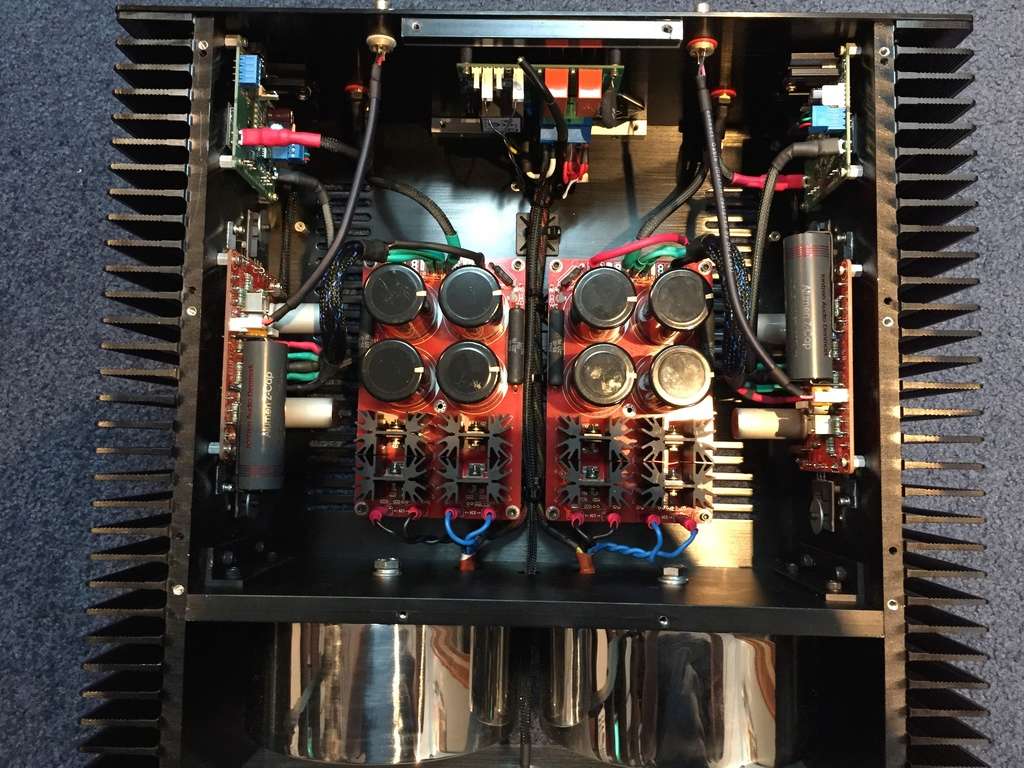
And it is more cheap than a BIG capacitors (105º) bank. I like very much the Mundorf but they are very expensive!!!
CRC Power Supply (Class A amplifier)
Dual CRC PSU for the USSA5, by pinocchio. Mundorf 33,000 uF (105º) x8.

Last edited:
Maty,
There is a nice thread about cap Mx over here:
Juma's Easy-Peasy Capacitance Multiplier
Lately, there was Darlington BJT output variant proposed by Mark Johnson that works very well. It has about -50dB ripple and a lower dropout voltage of about 1.3v and variable to higher values.
Note that for a cap Mx to work well, it has to have a dropout voltage equal to at least the ripple. So in that sense it loses some efficiency compared to just very large caps. But, it is easy to simply get a transformer rated for a slightly higher voltage.
Here is the Darlington based cap Mx:
Juma's Easy-Peasy Capacitance Multiplier
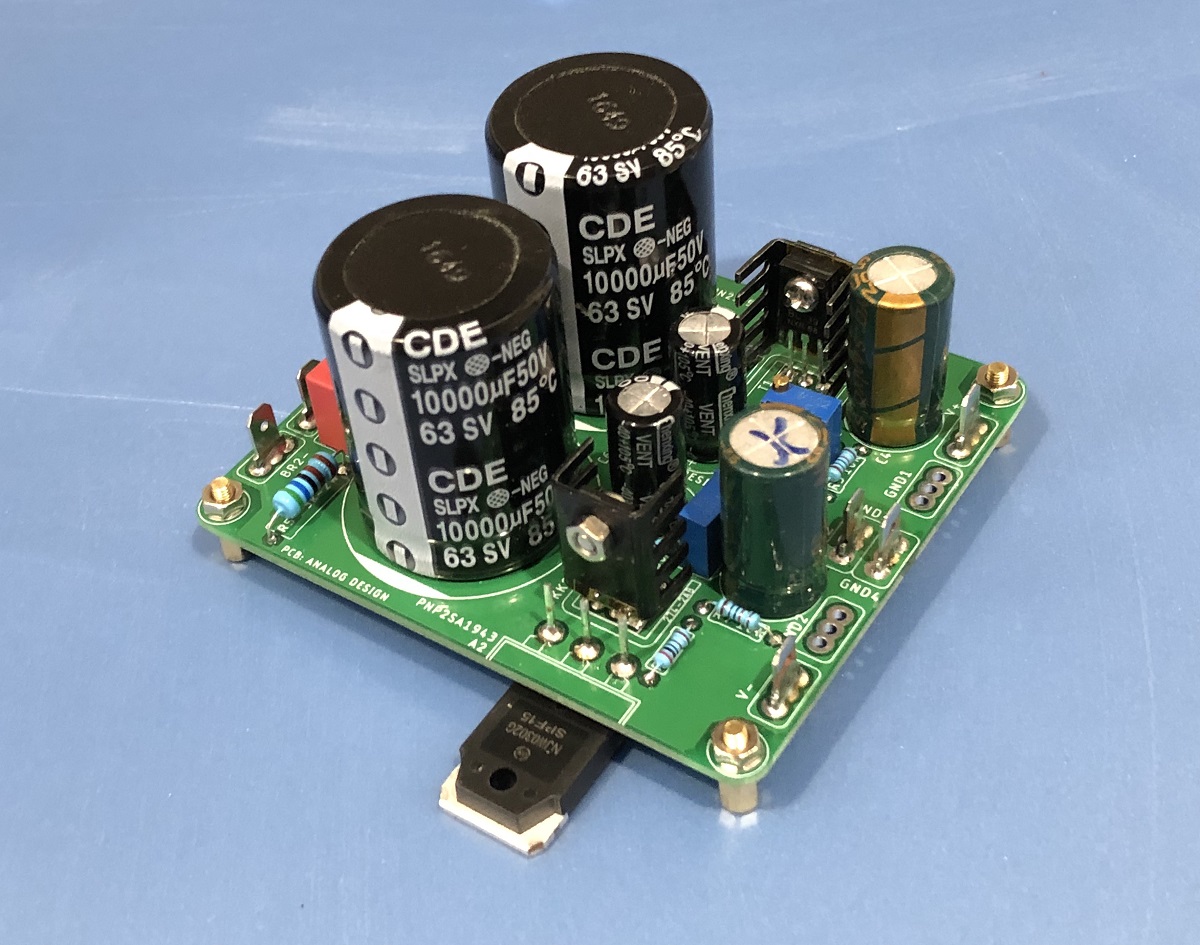
I am currently using this on my M2 amp with just a pair of 10,000uF caps per channel (vs 8 x 33,000uF caps as needed for the CRCRCC based on).
Prasi has also made a smaller version with SMT for preamps and HPA's etc (under 1A):
Juma's Easy-Peasy Capacitance Multiplier
I am working with another member on a CFP based cap mx that may show even better performance than the Darlington based one. I will share once tested and confirmed.
There is a nice thread about cap Mx over here:
Juma's Easy-Peasy Capacitance Multiplier
Lately, there was Darlington BJT output variant proposed by Mark Johnson that works very well. It has about -50dB ripple and a lower dropout voltage of about 1.3v and variable to higher values.
Note that for a cap Mx to work well, it has to have a dropout voltage equal to at least the ripple. So in that sense it loses some efficiency compared to just very large caps. But, it is easy to simply get a transformer rated for a slightly higher voltage.
Here is the Darlington based cap Mx:
Juma's Easy-Peasy Capacitance Multiplier
I am currently using this on my M2 amp with just a pair of 10,000uF caps per channel (vs 8 x 33,000uF caps as needed for the CRCRCC based on).
Prasi has also made a smaller version with SMT for preamps and HPA's etc (under 1A):
Juma's Easy-Peasy Capacitance Multiplier
I am working with another member on a CFP based cap mx that may show even better performance than the Darlington based one. I will share once tested and confirmed.
50 dB is an incredible good ripple attenuation!!!
In a new DIY build the transform with higher voltage values is not a problem.
I listen very good recordings, more of them are orchestral music with high DR (dynamic range) 13 dB until 17 dB (few tracks).
Can be they work with class AAB and/or AB amplifiers? Are the cap multipliers capable of providing the necessary current quickly in class AAB and/or AB?
In a new DIY build the transform with higher voltage values is not a problem.
I listen very good recordings, more of them are orchestral music with high DR (dynamic range) 13 dB until 17 dB (few tracks).
Can be they work with class AAB and/or AB amplifiers? Are the cap multipliers capable of providing the necessary current quickly in class AAB and/or AB?
Last edited:
Mundorf MLGO table. Ripple and ESR at 100 Hz.
To compare with the expensive Mundorf MLytic Audio Grade (AG) MLGO:
[PDF] http://www.mundorf.com/english 1.1/Broschuere Einzelseiten/MLGO.pdf
Um, wouldn't Zout be equal to (1/gm) plus (smallterm / Beta_squared) ? So at DC, about 33 milliohms when delivering 800mA?
To compare with the expensive Mundorf MLytic Audio Grade (AG) MLGO:
[PDF] http://www.mundorf.com/english 1.1/Broschuere Einzelseiten/MLGO.pdf
An externally hosted image should be here but it was not working when we last tested it.
Mundorf M-Lytic AG Capacitor 63V 22,000μF (ESR = 7 mOhms), the cheapest in EU here:
https://www.audiophonics.fr/en/cond...f-m-lytic-ag-capacitor-63v-22000f-p-5999.html
32,10 € tax incl.
26,75 € tax excl.
https://www.audiophonics.fr/en/cond...f-m-lytic-ag-capacitor-63v-22000f-p-5999.html
32,10 € tax incl.
26,75 € tax excl.
Last edited:
Hi Maty,
I have used it in CFH9 current feedback Class AB and the cap Mx works well. To get low ESR for cheap, I have used a cap array of 20 x 1000uF 60mOhm caps to get a 3mOhm ESR x 20,000uF equivalent cap after the cap Mx for cheap. These caps are sold in bags of 50 for $7.
Here is CFH9 Class AB amp with MOSFET cap Mx:
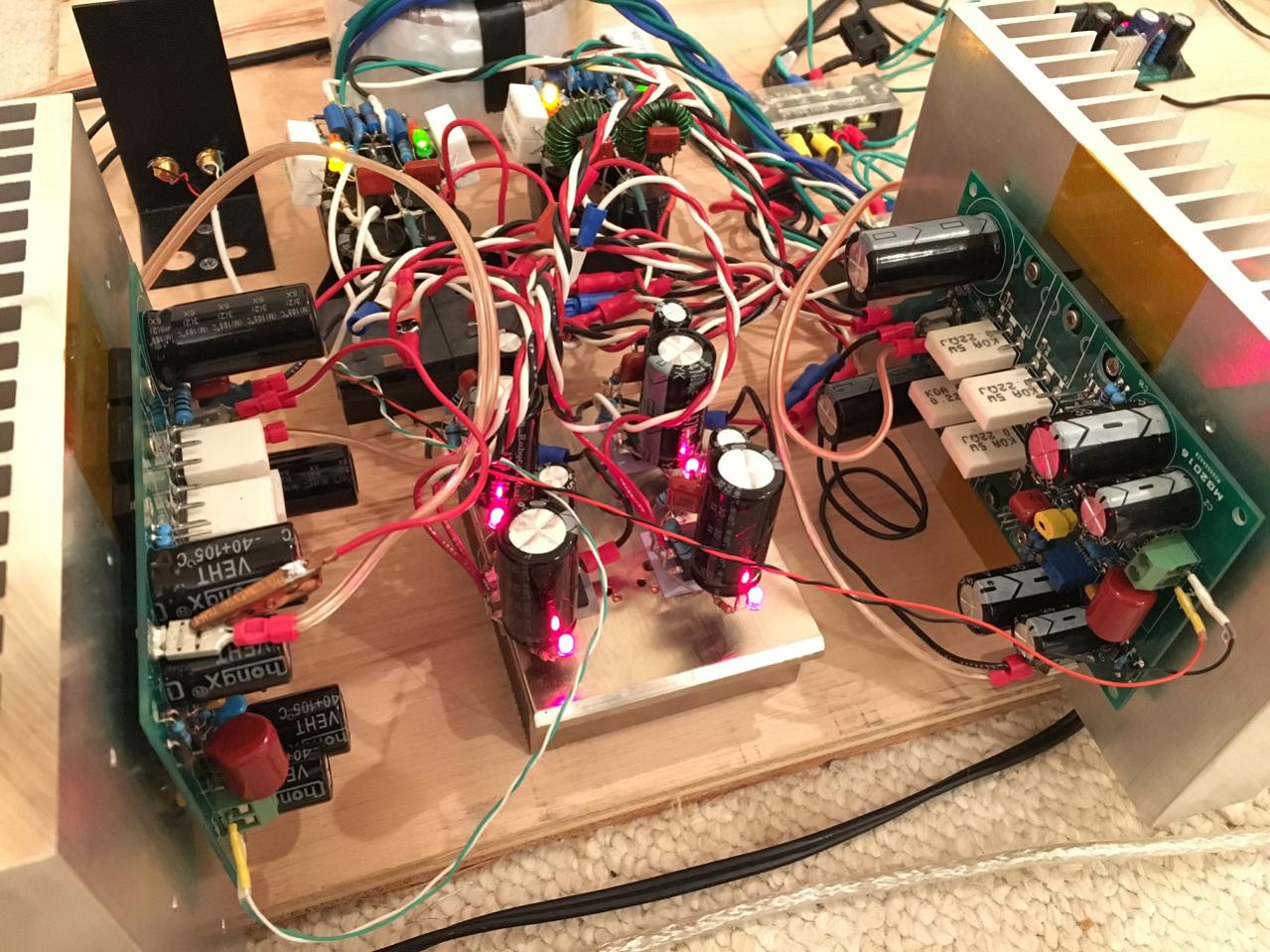
Here is cap bank being used with a Class A DLH amp:
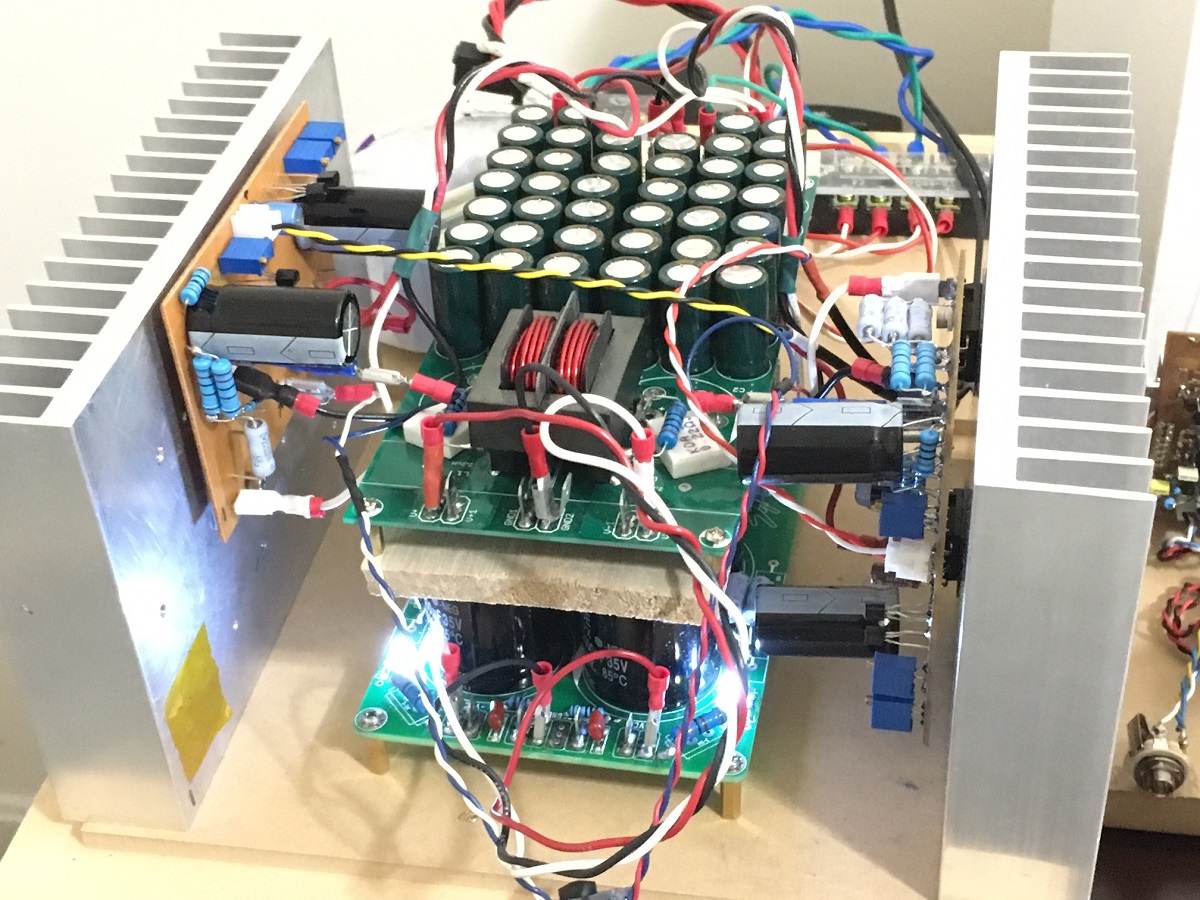
I am pretty sure I used the cap bank with a cap multiplier at some point but can’t remember the exact amp.
If you have more questions about cap Mx, maybe ask in that thread as this is a bit OT with respect to the original title thread.
Thanks,
X
I have used it in CFH9 current feedback Class AB and the cap Mx works well. To get low ESR for cheap, I have used a cap array of 20 x 1000uF 60mOhm caps to get a 3mOhm ESR x 20,000uF equivalent cap after the cap Mx for cheap. These caps are sold in bags of 50 for $7.
Here is CFH9 Class AB amp with MOSFET cap Mx:

Here is cap bank being used with a Class A DLH amp:
I am pretty sure I used the cap bank with a cap multiplier at some point but can’t remember the exact amp.
If you have more questions about cap Mx, maybe ask in that thread as this is a bit OT with respect to the original title thread.
Thanks,
X
Last edited:
Eventually you reach a point where the economic optimum is to build a full fledged voltage regulator with negative feedback. NFB circuits have incredibly low output impedance at (2 x fmains) if that's what gives you the woody, see excerpt from Jack Walton's article in Linear Audio, below. Pink line at 120Hz. Do you see 6 milliohms? Do you see 1 milliohm? Do you see 0.1 milliohms? Do you see 0.02 milliohms? I see them.
I happen to own a class-AB power amp (50 watts/channel into 8R) whose power supply is in fact a voltage regulator with huge amounts of NFB: the Akitika GT-101. Consider it an "existence proof" that NFB voltage regulators can indeed drive the rails of a class AB power amp. Akitika publishes all schematics online, including the schematic of the GT-101's voltage regulator / power supply. Have a look and calculate its Zout at 120 Hz, I expect your estimate will be very darn low.
_
I happen to own a class-AB power amp (50 watts/channel into 8R) whose power supply is in fact a voltage regulator with huge amounts of NFB: the Akitika GT-101. Consider it an "existence proof" that NFB voltage regulators can indeed drive the rails of a class AB power amp. Akitika publishes all schematics online, including the schematic of the GT-101's voltage regulator / power supply. Have a look and calculate its Zout at 120 Hz, I expect your estimate will be very darn low.
_
Attachments
Eventually you reach a point where the economic optimum is to build a full fledged voltage regulator with negative feedback..
You are the second person who told me today. The problem is finding one that works for a Class AB amplifier of about 100 watts at 8 Ohms. For DAC and headphones there is no problem.
Years ago I was about to buy the GT-101. I did not see clearly that such a low slew rate was enough to reproduce the transients of an orchestra. And I wanted more power by then. I had even thought about the improvements!
And yes, better in the other thread: Juma's Easy-Peasy Capacitance Multiplier
I happen to own a class-AB power amp (50 watts/channel into 8R) whose power supply is in fact a voltage regulator with huge amounts of NFB: the Akitika GT-101. Consider it an "existence proof" that NFB voltage regulators can indeed drive the rails of a class AB power amp. Akitika publishes all schematics online, including the schematic of the GT-101's voltage regulator / power supply. Have a look and calculate its Zout at 120 Hz, I expect your estimate will be very darn low.
_
I also happen to own an Akitika GT-101 and I have performed measurements on the regulated power supply. I measured 17mOhms output impedance @ 1.6A output current.
I also measured >1Mhz ringing on the turn-off edge. Although, this is unlikely to happen in a real amp due to the input bandwidth limiting filter slowing the slew rate compared to my switching load.
Perhaps Bonsai's next amplifier project, in a couple of years, will be a 200 watts/channel class AB amp with regulated supply rails of vanishingly low output impedance. Then when he unveils this amplifier, you can copy his regulator design, without needing to purchase twelve boutique electrolytic capacitors (at 26,75 € apiece) to get the output impedance you want.
Or perhaps it won't, who knows. I can't speak for Bonsai but I do know that MY next power amplifier project, will definitely not have voltage regulators on the supply rails.
Or perhaps it won't, who knows. I can't speak for Bonsai but I do know that MY next power amplifier project, will definitely not have voltage regulators on the supply rails.
I used cap multipliers on the e-Amp (180 Watt per channel VFA) for the front end stages up to the VAS. I think there’s about 30 or 40 dB ripple attenuation IIRC.
For class A amps they bring a real benefit - and especially CFA. A good VFA should have very high PSRR.
I agree though that spending a fortune on boutique capacitors is a high road to nowhere - as are commercial products that boast about ‘500 000 uF’ PSU capacitors.
An image of Don Quixote and windmills comes to mind.
For class A amps they bring a real benefit - and especially CFA. A good VFA should have very high PSRR.
I agree though that spending a fortune on boutique capacitors is a high road to nowhere - as are commercial products that boast about ‘500 000 uF’ PSU capacitors.
An image of Don Quixote and windmills comes to mind.
Last edited:
Boutique and expensive capacitors but very good caps too.
Two Mundorf MLGO in a DC Blocker or class AB PSU is a very good choice. Verified by me with my first DCB, the prototype.
The same DCB with Mundorf MLytic Audio Grade (AG) MLGO 25VDC / 47000µF, 125°C vs EPCOS:
* Much better than: EPCOS B41231A7159M000 15000 µF, 35 V, 85°C (inside the prototype)
* Better than: EPCOS B41505A7189M000 18000 µF, 35 V, 105° (out of stock) (inside the others DCB, DCBx2 and DCBx4).
https://www.audiocircle.com/index.php?topic=153802.msg1667381#msg1667381
Two Mundorf MLGO in a DC Blocker or class AB PSU is a very good choice. Verified by me with my first DCB, the prototype.
The same DCB with Mundorf MLytic Audio Grade (AG) MLGO 25VDC / 47000µF, 125°C vs EPCOS:
* Much better than: EPCOS B41231A7159M000 15000 µF, 35 V, 85°C (inside the prototype)
* Better than: EPCOS B41505A7189M000 18000 µF, 35 V, 105° (out of stock) (inside the others DCB, DCBx2 and DCBx4).
https://www.audiocircle.com/index.php?topic=153802.msg1667381#msg1667381
Months ago, my TV system:
DCB (prototype, cheap EPCOS) + DCB + DCBx2
Until a week ago:
DCB (prototype, cheap EPCOS) + DCBx2
Now:
DCB (mundorf) + DCBx2
and just now is Monday night. The TV sound is much better than a week ago and better than months ago! TDT TV with sound from an AV Yamaha.
DCB and DCBx2 with much expensive and better EPCOS capacitors than the original DCB prototype.
In other words:
DCB proto with Mundorf is better than DCB proto + DCB.
kx-Amplifier PCB's are back in stock at Jim's Audio here:-
Hifisonix kx Low Dist ,Wide BW 25 W Class A, 50W classAB CFA Amp PCB set stereo! | eBay
The new batch of boards are as before, but now include gold plating.
As always, any questions, let me know.
Hifisonix kx Low Dist ,Wide BW 25 W Class A, 50W classAB CFA Amp PCB set stereo! | eBay
The new batch of boards are as before, but now include gold plating.
As always, any questions, let me know.
- Home
- Amplifiers
- Solid State
- Hifisonix kx-Amplifier

